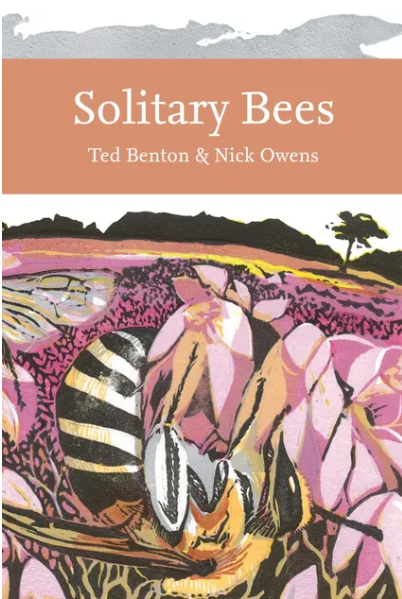Solitary Bees, is the latest edition to the Collins New Naturalist series. In this blog, Library Volunteer, Helen Chester, reviews this exciting book.
Ted Benton & Nick Owens’ book Solitary Bees is the latest title in the long-running New Naturalist series. This book focuses on an easily overlooked group of bees which are represented in Britain by about 244 species. Solitary bees are bees that do not use an infertile worker caste in the nest (such as that seen in the familiar honeybee hive), although they don’t necessarily all nest alone. While some species truly do build nests in isolation, others construct nests in groups, possibly for protection. Some types, including several species of mining bees, even share a communal nest entrance.
In the book’s introduction, Benton and Owens explained that solitary bees can be harder to study than their social counterparts, even though they are more diverse. It is difficult for entomologists to identify a particular species while studying them in nature. They also tend to receive a lot less attention than Honey Bees and bumble bees. However, signs of their activity can be spotted in various habitats. For example, in gardens, the holes found in plants can be evidence of leafcutter bees gathering nest-lining materials. There are now more resources available for the identification of solitary bees, and digital photography has made a huge contribution to their study. In fact, this book makes great use of colourful macro photographs and easy to understand diagrams that show the vast array of solitary bee forms and their physical adaptations to their lifestyles. Benton and Owens’ book is intended to be an accessible and up-to-date guide to these overlooked bees that draws on the latest research.

The book goes into detail about the different types of solitary bee and their wide-ranging lifestyles. For example, solitary bees have a huge variety of methods for constructing nests. Some bees make use of pre-existing cavities such as holes in man-made masonry, hollows in plants, or even abandoned snail shells. Some bees nest on the ground by building burrows of various sizes. I was surprised to learn that Large-headed Resin Bees, as the name suggests, use pieces of resin to build their nests. They then embed other materials such as small pebbles into the resin. Other bees, called Cuckoo Bees, behave in a similar way to their avian namesake and replace the eggs of another species with their own offspring. There are about 73 species of cuckoo bees from six different genera.
I would recommend this book if you want to learn more about a lesser known group of bees. There is a huge amount of detail about different bee species and the complexity of their life cycles.
You can find this book in the Great North Museum: Hancock library.